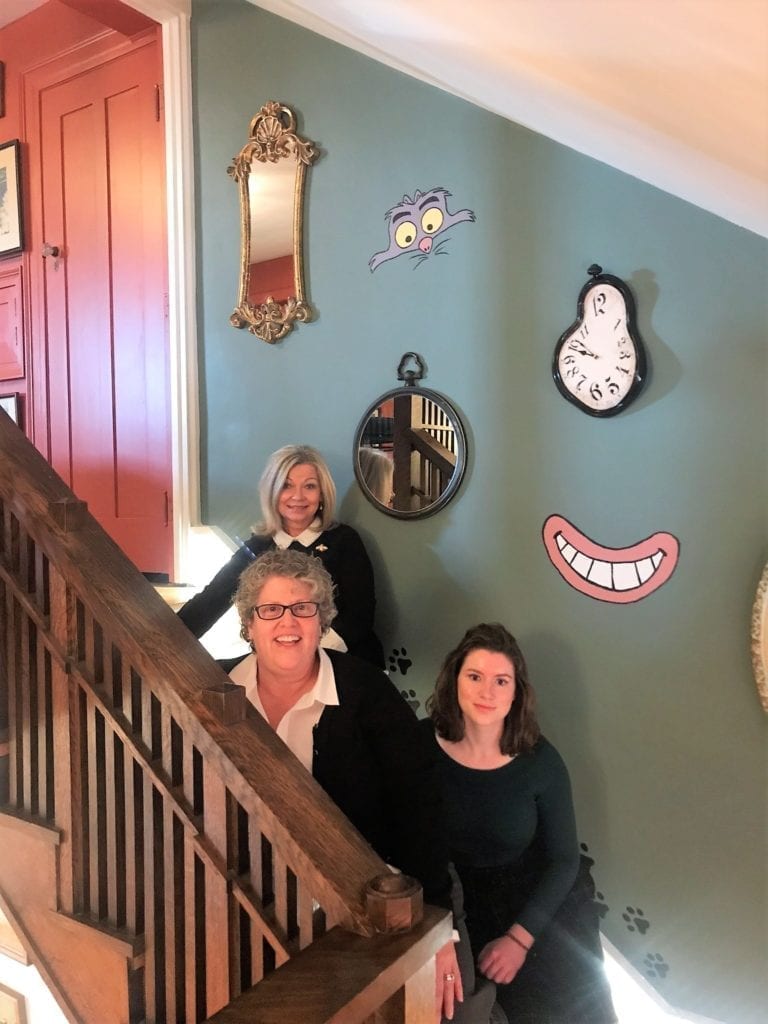Last week, a group of 14 Villa Maria interior design students put the finishing touches on a project that’s been in the work for over a year.
In October 2018, the team of 15 began the process of the designing a space in the 2019 Decorators’ Show House, a private residence that opens its doors to a slew of interior designers from Western New York-based firms and schools to be redone room by room. This year’s site is The Palmer Centennial House, an arts-and-crafts style home designed by architect Ulysses G. Orr in 1910. The home, which is located at 288 Lincoln Parkway in Buffalo, was owned by one of the original founding members of the Junior League of Buffalo, which hosts the Show House annually.
During an initial walk through, the team scoped out three spaces they were interested in designing. Three students completed a rendering for each space, submitted them to the Junior League of Buffalo for review, and waited to hear back about their official space assignment. In the end, the group was assigned the third floor landing (space 15 below), which was designed by junior Lauren Kielma.

“When we first walked through the house, the owners were still living here with all their stuff in it,” said Mindy Robins, a two-year interior design student at Villa and the manager of the Show House project. “We were able to see how they were using all the spaces in their own home. The landing that we were assigned was totally empty, except for a pair of old skis that they had hung on the wall, so we thought that the owner saw this space as a waste.”
One month later, the home owners moved out and completely emptied the home so the team could get in and take measurements. “This is when the fun started,” said Robins. “We spent the next few weeks planning and were able to actually begin working on the space on March first. Throughout March, we were able to have someone in here working two days a week and, since April first, we’ve had someone here working every day except for Easter Sunday.”
After measuring day, the group ran into its first real-world challenge. “After taking measurements, we realized that we’d have to make some changes to our original design,” said Bridget Schiltz, ’21. “We remembered the space to be a lot bigger than it actually was. The table was originally supposed to be 6-feet long but, after measuring, we decided it had to be shortened to 5 feet. Once you’re able to get back in there and really see all aspects of the landing space, everything changes. We remembered the ceiling being much lower, too, so we thought there would be more of the wallpaper showing.”
“There’s nothing like being in the space,” agreed Reicis. “After spending time in there, we realized that the back corner was empty and you could see it longer [as you walked up the stairs into the landing space]. That’s where the idea of the birch logs came into play. They were actually borrowed from Bridget’s mom’s house, but they play off the birch tree-patterned wallpaper perfectly. It was a good lesson to learn: that drawings only get you so far and you have to spend time in the space to really understand it.”

Under the experienced eye of Professor Reicis, students brought Kielma’s rendering to life in a small space that would have been easy to disregard.
The landing space, which is actually a 12 ft. by 8 ft. rectangle, was a challenging space to work with but the team of student designers was immediately inspired. “We came up with an ‘Alice in Wonderland’ theme,” said Robins. “The whole design started with the birch tree wallpaper that Lauren [Kielma] found online while she was creating the initial rendering of the space. We had talked about incorporating the wilderness and Alice being outside and the design evolved from there.”
Because of the truncated height of the landing space, the group knew they’d have to create an area for children. “We worked with Assistant Professor of Interior Design and Art Shop Supervisor Jesse Walp to create the table from scratch,” said Robins. “We knew we’d never find a table with the waves we envisioned that was also a child’s height, so we made it instead.”
Lighting also posed an issue for the team as they worked to create their whimsical space. “The only light that was there originally was a wall sconce,” said Reicis. “We knew we needed to add lighting, especially because the Show House is open at night. If we didn’t add in lighting guests wouldn’t be able to see anything.” Rather than simply finding a spot to stick lamp, which might have impeded traffic through their space which is between the second and third floors, the group got creative. “We added the lights under the table to help brighten up the space without compromising our vision.”

Despite the table adding some light to the space, the Junior League became concerned about the lack of light by the stairs. “The Junior League asked us to include a lamp on the table,” said Reicis. “But we knew it wouldn’t work. We got creative again and came up with the idea to run the lights under the stairs.”
The lighting issues were easily overcome thanks to Robins and Schiltz. “Lighting is something a lot of students overlook in their studio projects,” said Reicis. “But Mindy and Bridget prioritized their schedules to take the lighting class early, which really benefited the group as they worked through things.”
“Understanding how much lighting plays into things and the impact it can have on colors was helpful, too” said Schiltz. “As an example, when we first found the wallpaper, its background seemed to have more pink in it. When we got it in its final spot in the landing it definitely shows more grey. We had the challenge of seeing how things looked in the resource room [on campus] versus how they look in the space with the lighting that we have here.”
With the lighting issues finally conquered, the team was able to shift their focus back to the details of their space. “The table is set for a tea party, complete with intricate teacups and plates. The teacups were donated by one of our part-time faculty, Veronica Ryskalczyk, who used them for her wedding,” said Reicis. “The students picked a few cups and then worked with Sister Ann Therese Kelly to design and fabricate the glass plates to match the cups.”
Besides the table, the space was meticulously decorated with black and white line drawings featuring Alice in Wonderland characters, clear plastic chairs adorned with the iconic Mad Hatter’s hat and a white rabbit, a table featuring a miniature version of the light-up table and chairs, cherry blossom flowers and the Cheshire Cat’s tail emerging from the table.
The Cheshire Cat, which was hand painted by sophomore Taylor Grodesky, extends up the staircase. His smile, eyes, and paw prints are carefully placed among three decorative mirrors and melting clock.

Professor of Interior Design Sandra Reicis (top), Project Manager Mindy Robins (center) and Sophomore Bridget Schiltz sit on the stairs that lead from their landing space to the home’s third floor.

Although Robins referred to the window treatments as a ‘no brainer,’ they show the attention to detail the team paid as they designed the space. “If we were outside this is what you would see, she said of the greenery that was placed between the outside window and the storm window. “Professor Reicis was really helpful in completing all of the window treatments, and they are the perfect finishing touch that brings more of the outside into our space.”

The group completed the space with a grey leather shag rug and student-made glass butterflies, both of which were used in the show house Villa students worked on two years ago.
“What I love, and this is a testament to interior design and our students, is that a lot of people would have looked at this area and discarded it as wasted space,” said Reicis. “They would have walked away thinking it was unworkable, and I love that we took a space that was marginalized by so many others and made it so fantastic.”

This year marks the 18th year in Villa’s relationship with the Junior League, and the 9th show house the College’s interior design students have worked on. According to Reicis, interior design students at Villa have worked on some of the area’s most notable homes, including E.B. Green’s Robert Donner House and the Knox Farm Summer Residence.
Each year that Villa students play a role in designing the Junior League Show House provides them with valuable real-world experience that mimics the projects young professionals can expect to experience as they enter and advance in the work place.
“As the project manager, I think my biggest real-world struggle was the experience of working with a number of different people in all different aspects,” said Robins. “I had to make sure personal schedules were coordinated with our work schedule and that things were getting done on time. Sometimes I had to step in and do things myself to make sure we stayed on schedule. I think being able to coordinate and work with people in many different aspects is a big part of interior design.”
For Bridget, the biggest real-world takeaway was seeing the entire development process unfold. “When we did the initial rendering, a lot of things were different,” she said. “The chairs were different, the table was longer, and there was a giant mushroom between the table and the wall. We had to redevelop the design as we went. Once you do something you can see what works and what doesn’t, and then you adjust and keep going.”
Both Schiltz and Robins agree that, overall, this project was a very collaborative one. “We had a lot of group meetings and made decisions based on consensus,” said Robins. “We were respectful of one another and good at coming together. We were all always on the same page because we all wanted a good outcome.”
Reicis agreed. “There’s a difference between collaborating and cooperating,” she said. “When you’re cooperating, you don’t necessarily commit to it, it’s kind of a ‘whatever, just do it and I’ll go along with it.’ But everyone was working towards making this as great a project as possible. That consensus and collaboration was really nice to see. It’s another example of how this project provides real world experience for students.”
All together, Professor Reicis and her students spent hundreds of hours designing, fabricating and actually putting the space together. In addition to attending classes, completing assignments and, in some cases, raising families and working, students dedicated full-time job hours to bring their space to life.
“The students definitely did their part,” said Reicis. “They gained lots of valuable experience about what goes into finishing a space. We do tons of space planning in class, but we can’t teach construction snafus, scheduling issues, other surprises once you get in there. You think you can start working on a certain day but there’s plumbing issues, or a ceiling leak, or a last minute change of paint colors. This project is all about learning to live with and work around these issues, and understanding that your deadline doesn’t change because of them.”
The fully decorated Show House will be open to the public until May 19, 2019. Tickets can be purchased here or at the door. To learn more about studying interior design at Villa, visit villa.edu/academics/academic-programs/interior-design.
